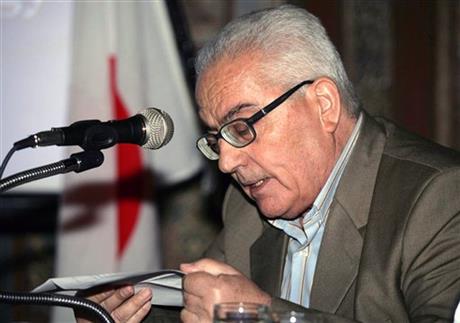
By ALBERT AJI and BASSEM MROUE
Islamic State militants beheaded a leading Syrian antiquities scholar who spent most of his life looking after the ancient ruins of Palmyra, then hung his body from a pole in a main square of the historic town, Syrian activists and the scholar’s relatives said Wednesday.
The killing of 81-year-old Khaled al-Asaad was the latest atrocity perpetrated by the militant group, which has captured a third of both Syria and neighboring Iraq and declared a self-styled “caliphate” on the territory it controls.
Since IS overran Palmyra in May, there have been fears the extremists, who have destroyed famed archaeological sites in Iraq, would demolish the 2,000-year-old Roman-era city at the edge of the town — a UNESCO world heritage site and one of the Mideast’s most spectacular archaeological sites.
The Sunni extremist group, which has imposed a violent interpretation of Islamic law, or Shariah, believes ancient relics promote idolatry. IS militants claim they are destroying ancient artifacts and archaeological treasures as part of their purge of paganism. The destruction IS has wreaked adds to the wider, extensive damage it has inflicted on ancient sites, including mosques and churches across Syria and Iraq.
According to Syrian state news agency SANA, al-Asaad was beheaded on Tuesday in a square outside the town’s museum.
A Palmyra-based Syrian opposition activist who uses the name Khaled al-Homsi and who identified himself also as a nephew of al-Asaad, said Islamic State militants detained the scholar around three weeks ago. On Tuesday, they brought him in a van to a square packed with shoppers.
A militant then read out five alleged IS charges against al-Asaad, including that he was the “director of idols,” represented Syria “at infidel conferences” and visited Shiite powerhouse Iran.
Then, another militant pulled out a knife at which point al-Khamsi said he left the square, unable to watch. Al-Asaad’s body was later hung from a pole on a main street.
The Palmyra archaeological site was al-Assad’s “life,” said al-Homsi, his voice shaking and adding that he fled the town later on Tuesday.
Even when he grew old and could no longer go to the Roman ruins, al-Asaad “lived close to the site and he could see the archaeological site from his house,” al-Khamsi added.
Maamoun Abdulkarim, the head of the Antiquities and Museums Department in Damascus, had earlier told SANA that al-Asaad’s body was taken to Palmyra’s archaeological site and hung from one of the Roman columns. But several activists denied that was the case.
Al-Asaad was “one of the most important pioneers in Syrian archaeology in the 20th century,” Abdulkarim said. IS had tried to extract information from him about where some of the town’s treasures had been hidden to save them from the militants, the antiquities chief also said.
SANA said al-Asaad had been in charge of Palmyra’s archaeological site for four decades until 2003, when he retired. After retiring, al-Asaad worked as an expert with the Antiquities and Museums Department.
Al-Asaad, who held a diploma in history and education from the University of Damascus, wrote many books and scientific texts either individually or in cooperation with other Syrian or foreign archeologists, SANA said. Among his titles are “The Palmyra sculptures,” and “Zenobia, the Queen of Palmyra and the Orient.”
He also discovered several ancient cemeteries, caves and the Byzantine cemetery in the garden of the Museum of Palmyra, the agency added.
“Al-Asaad was a treasure for Syria and the world,” Khalil Hariri, al-Asaad’s son-in-law who works at the Palmyra’s archaeological department told The Associated Press, speaking over the phone from the central Syrian city of Homs. “Why did they kill him?”
“Their systematic campaign seeks to take us back into pre-history,” he added. “But they will not succeed.”
Hariri, who is married to al-Asaad’s daughter, Zenobia, said his father-in-law had been a member of President Bashar Assad’s ruling Baath party since 1954. Hariri added that al-Asaad is survived by six sons and five daughters. Al-Asaad is not related to President Assad.
Since falling to IS, Palmyra’s ancient site has remained intact but the militants destroyed a lion statue in the town dating back to the 2nd century. The statue, discovered in 1975, had stood at the gates of the town museum, and had been placed inside a metal box to protect it from damage.
In early July, IS released a video showing the killing of some 20 captured government soldiers in Palmyra’s amphitheater. They were shot dead by young IS members, armed with pistols. Hundreds of people were seen watching the killings.
Also Wednesday, an IS suicide bomber targeted a predominantly Kurdish town in northeastern Syria, killing at least 13 people, SANA said.
The Britain-based Syrian Observatory for Human Rights said the explosion happened outside a local Kurdish police station in the town of Qamishli. It also said more than 40 people were wounded in the blast.
The IS claimed responsibility for the blast. The group has been fighting Kurdish fighters in Syria since last year and the extremists have carried out dozens of suicide attacks against the Kurds. The Kurdish fighters, aided by U.S.-led airstrikes, have also captured significant territory from IS in northern Syria.
___
Mroue reported from Beirut.
___
This story has been corrected to show that the slain scholar’s name is al-Asaad per AP style, not Asaad.



